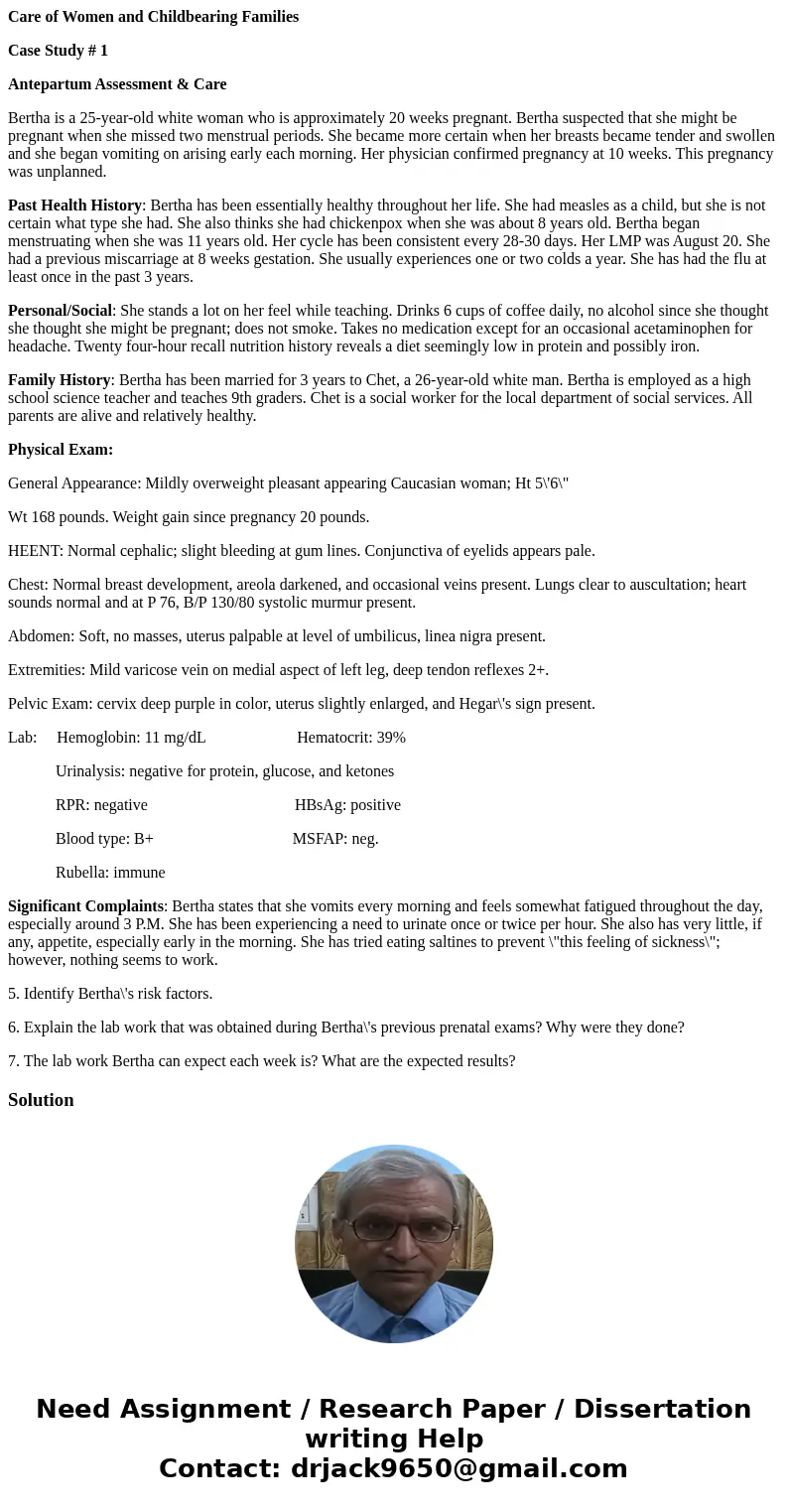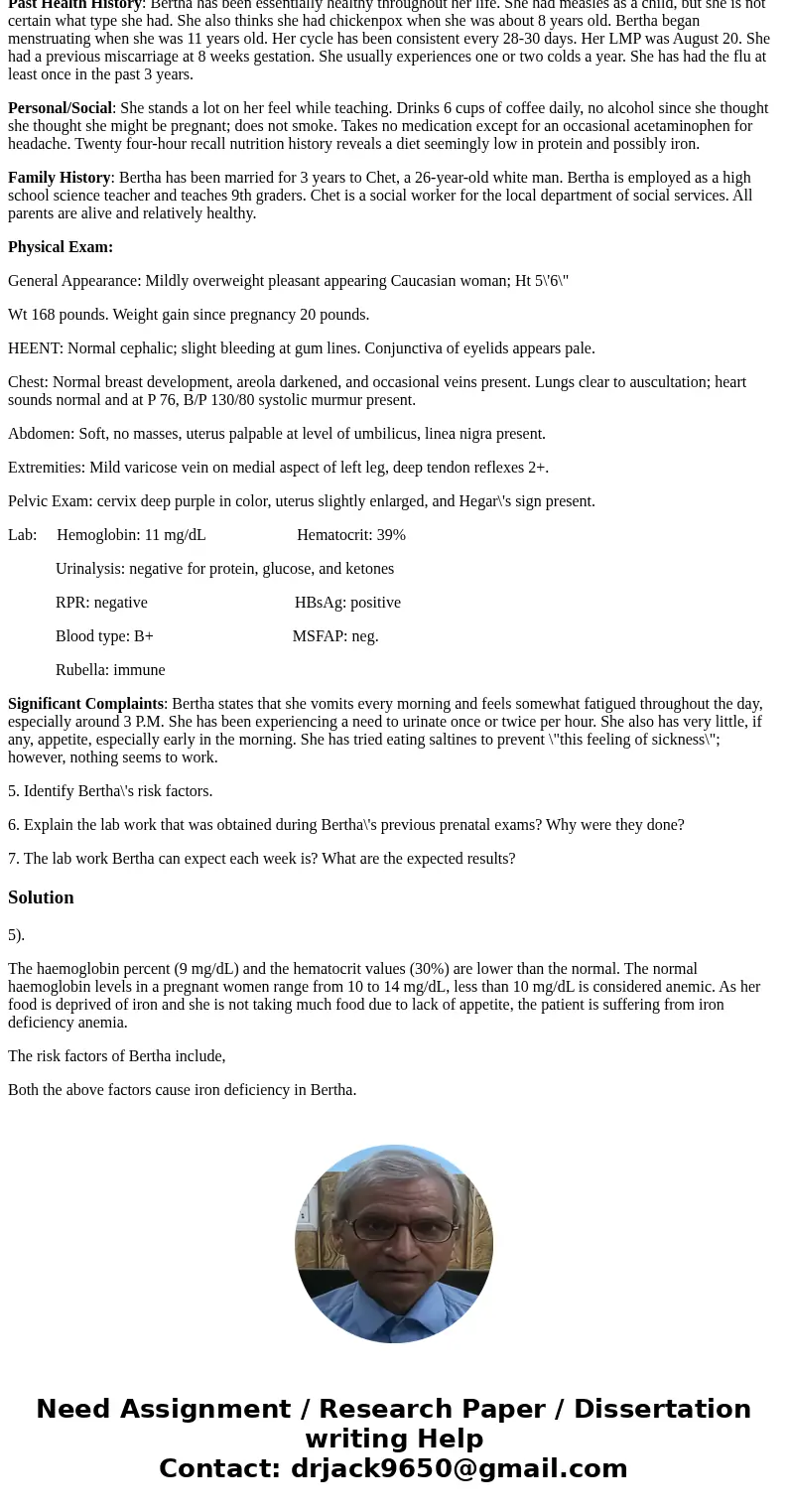Care of Women and Childbearing Families Case Study 1 Antepa
Care of Women and Childbearing Families
Case Study # 1
Antepartum Assessment & Care
Bertha is a 25-year-old white woman who is approximately 20 weeks pregnant. Bertha suspected that she might be pregnant when she missed two menstrual periods. She became more certain when her breasts became tender and swollen and she began vomiting on arising early each morning. Her physician confirmed pregnancy at 10 weeks. This pregnancy was unplanned.
Past Health History: Bertha has been essentially healthy throughout her life. She had measles as a child, but she is not certain what type she had. She also thinks she had chickenpox when she was about 8 years old. Bertha began menstruating when she was 11 years old. Her cycle has been consistent every 28-30 days. Her LMP was August 20. She had a previous miscarriage at 8 weeks gestation. She usually experiences one or two colds a year. She has had the flu at least once in the past 3 years.
Personal/Social: She stands a lot on her feel while teaching. Drinks 6 cups of coffee daily, no alcohol since she thought she thought she might be pregnant; does not smoke. Takes no medication except for an occasional acetaminophen for headache. Twenty four-hour recall nutrition history reveals a diet seemingly low in protein and possibly iron.
Family History: Bertha has been married for 3 years to Chet, a 26-year-old white man. Bertha is employed as a high school science teacher and teaches 9th graders. Chet is a social worker for the local department of social services. All parents are alive and relatively healthy.
Physical Exam:
General Appearance: Mildly overweight pleasant appearing Caucasian woman; Ht 5\'6\"
Wt 168 pounds. Weight gain since pregnancy 20 pounds.
HEENT: Normal cephalic; slight bleeding at gum lines. Conjunctiva of eyelids appears pale.
Chest: Normal breast development, areola darkened, and occasional veins present. Lungs clear to auscultation; heart sounds normal and at P 76, B/P 130/80 systolic murmur present.
Abdomen: Soft, no masses, uterus palpable at level of umbilicus, linea nigra present.
Extremities: Mild varicose vein on medial aspect of left leg, deep tendon reflexes 2+.
Pelvic Exam: cervix deep purple in color, uterus slightly enlarged, and Hegar\'s sign present.
Lab: Hemoglobin: 11 mg/dL Hematocrit: 39%
Urinalysis: negative for protein, glucose, and ketones
RPR: negative HBsAg: positive
Blood type: B+ MSFAP: neg.
Rubella: immune
Significant Complaints: Bertha states that she vomits every morning and feels somewhat fatigued throughout the day, especially around 3 P.M. She has been experiencing a need to urinate once or twice per hour. She also has very little, if any, appetite, especially early in the morning. She has tried eating saltines to prevent \"this feeling of sickness\"; however, nothing seems to work.
5. Identify Bertha\'s risk factors.
6. Explain the lab work that was obtained during Bertha\'s previous prenatal exams? Why were they done?
7. The lab work Bertha can expect each week is? What are the expected results?
Solution
5).
The haemoglobin percent (9 mg/dL) and the hematocrit values (30%) are lower than the normal. The normal haemoglobin levels in a pregnant women range from 10 to 14 mg/dL, less than 10 mg/dL is considered anemic. As her food is deprived of iron and she is not taking much food due to lack of appetite, the patient is suffering from iron deficiency anemia.
The risk factors of Bertha include,
Both the above factors cause iron deficiency in Bertha.


 Homework Sourse
Homework Sourse